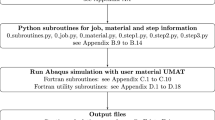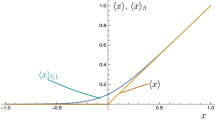Abstract
For finite-strain plasticity with anisotropic yield functions and anisotropic hyperelasticity, we use the Kröner-Lee decomposition of the deformation gradient combined with a yield function written in terms of the Mandel stress. The source is here the right Cauchy-Green tensor provided by a FE discretization. For the integration of the flow law we adopt a scaled/squared series approximation of the matrix exponential, which is compared with a classical backward-Euler method. The exact Jacobian of the second Piola-Kirchhoff stress is determined with respect to this source, consistent with the approximation. The resulting system is produced by symbolic source-code generation for each yield function and hyperelastic strain-energy density function. The constitutive system is solved by a damped Newton-Raphson algorithm for the plastic multiplier and the elastic right Cauchy-Green tensor \(\varvec{C}_{e}\). To ensure power-consistency, we make use of the elastic Mandel stress construction. Two numerical examples exhibit the comparative effectiveness of the Algorithm for very large elastic and plastic deformations. The elasto-plastic pinched cylinder makes use of as few as 2 steps for the total radius displacement of 300 mm and only 25 steps are required for the cup drawing problem.










Similar content being viewed by others
References
Betsch P, Stein E (1999) Numerical implementation of multiplicative elasto-plasticity into assumed strain elements with application to shells at large strains. Comp Method Appl Mech Eng 179:215–245
Bennett KC, Regueiro RA, Luscher DJ (2019) Anisotropic finite hyper-elastoplasticity of geomaterials with drucker-prager/cap type constitutive model formulation. Int J Plast 123:224–250
Andelfinger U, Ramm E (1993) EAS-elements for two-dimensional, three-dimensional, plate and shell structures and their equivalence to HR-elements. Int J Numer Methods Eng 36:1311–1337
Buchter N, Ramm E, Roehl D (1994) Three-dimensional extension of nonlinear shell formulation based on the enhanced assumed strain concept. Int J Numer Methods Eng 37:2551–3568
Areias P, Mota Soares CA, Rabczuk T, Garçao J (2016) A finite-strain solid-shell using local Löwdin frames and least-squares strains. Comp Method Appl Mech Eng 311:112–133
Eidel B, Gruttmann F (2003) Elastoplastic orthotropy at finite strains: multiplicative formulation and numerical implementation. Comput Mater Sci 28:732–742
Mandel J (1973) Equations constitutives et directeurs dans les milieux plastiques et viscoplastiques. Int J Solids Struct 9:725–740
Simo JC (1992) Algorithms for static and dynamic multiplicative plasticity that preserve the classical return mapping schemes of the infinitesimal theory. Comp Method Appl Mech Eng 99:61–112
Cuitiño A, Ortiz M (1992) A material-independent method for extending stress update algorithms from small-strain plasticity to finite plasticity with multiplicative kinematics. Eng Comput 9:437–451
de Souza Neto EA, Perić D, Owen DRJ (2008) Computational methods for plasticity: theory and applications. Wiley, West Sussex
Shutov AV (2018) Efficient time stepping for the multiplicative Maxwell fluid including the Mooney-Rivlin hyperelasticity. Int J Numer Methods Eng 113(12):1851–1869
Bonet J, Wood RD (2008) Nonlinear continuum mechanics for finite element analysis, 2nd edn. Cambridge University Press, Cambridge
Simo JC, Hughes TJR (2000) Computational inelasticity, Corrected 2 edn. Springer, Berlin
Areias P, Belytschko T (2006) Analysis of finite strain anisotropic elastoplastic fracture in thin plates and shells. J Aerospace Eng 19(4):259–270
Ortiz M, Radovitzky RA, Repetto EA (2001) The computation of the exponential and logarithmic mappings and their first and second derivatives. Int J Numer Methods Eng 52:1431–1441
Korelc J, Stupkiewicz S (2014) Closed-form matrix exponential and its application. Int J Numer Methods Eng 98:960–987
Moler C, Van Loan C (2003) Nineteen dubious ways to compute the exponential of a matrix, twenty-five years later. SIAM Rev 45(1):1–46
Ward RC (1977) Numerical computation of the matrix exponential with accuracy estimate. SIAM J Numer Anal 14(4):600–610
Higham NJ (2009) The scaling and squaring method for the matrix exponential revisited. SIAM Rev 51(4):747–764
Cheng H-W, Yau SS-T (1997) More explicit formulas for the matrix exponential. Linear Algebra and its Applications, vol 262, pp 131–163
Lu J (2004) Exact expansions of arbitrary tensor functions \({\mathbf{F}}({\mathbf{A}})\). Int J Solids Struct 41:337–349
de Souza Neto EA (2001) The exact derivative of the exponential of an unsymmetric tensor. Comput Method Appl Mech Eng 190:2377–2383
Fung TC (2004) Computation of the matrix exponential and its derivatives by scaling and squaring. Int J Numer Method Eng 59:1273–1286
Sastre J, Ibánez J, Defez E, Ruiz P (2015) New scaling-squaring Taylor. SIAM J Sci Comput 37(1):A439–A455
Baaser H (2004) The Padé-approximation for matrix exponentials applied to an integration algorithm preserving plastic incompressibility. Comput Mech 34:237–245
Areias P, Matouš K (2008) Finite element formulation for modeling nonlinear viscoelastic elastomers. Comput Method Appl Mech Eng 197:4702–4717
Al-Mohy AH, Higham NJ (2009) A new scaling and squaring algorithm for the matrix exponential. SIAM J Matrix Anal Appl 31(3):970–989
Kröner E (1960) Allgemeine kontinuumstheorie der versetzungen und eigenspannungen. Arch Ration Mech Anal 4:273–334
Lee EH, Liu DT (1967) Finite strain elastic-plastic theory particularly for plane wave analysis. J Appl Phys 38(1):19–27
Lee EH (1969) Elasto-plastic deformation at finite strains. J Appl Mech-ASME 36:1–6
Lubliner J (1990) Plasticity theory. Macmillan, Basingstoke
Mandel J (1974) Foundations of continuum thermodynamics. Thermodynamics and plasticity. MacMillan, London, pp 283–304
Gurtin ME (1981) An introduction to continuum mechanics, volume 158 of Mathematics in Science and Engineering. Academic Press, New York
Coleman BD, Noll W (1963) The thermodynamics of elastic materials with heat conduction and viscosity. Arch Rational Mech Anal 13:167–178
Vladimirov I, Pietryga MP, Reese S (2010) Anisotropic finite elastoplasticity with nonlinear kinematic and isotropic hardening and application to sheet metal forming. Int J Plast 26:659–687
Wolfram Research Inc. (2007) Mathematica
Korelc J (2002) Multi-language and multi-environment generation of nonlinear finite element codes. Eng Comput 18(4):312–327
Bickart TA (1968) Matrix exponential: Approximation by truncated power series. Proc IEEE 56:372–373
Petersen KB, Pedersen MS (2012) The matrix cookbook
Areias P (2021) Mandel-based plasticity with series exponential. https://github.com/PedroAreiasIST/MandelExponential
Murphy JG (2013) Transversely isotropic biological, soft tissue must be modelled using both anisotropic invariants. Eur J Mech A/Solids 42:90–96
Wriggers P (2008) Nonlinear finite element methods. Springer, Berlin
Barlat F, Aretz H, Yoon JW, Karabin ME (2005) Linear transformation-based anisotropic yield functions. Int J Plast 21:1009–1039
Yoshida F, Hamasaki H, Uemori T (2013) A user-friendly 3d yield function to describe anisotropy of steel sheets. Int J Plast 45:119–139
Hill R (1948) A theory of yielding and plastic flow of anisotropic metals. Proc R Soc Lond 193:281–297
Areias P Simplas. http://www.simplassoftware.com. Portuguese Software Association (ASSOFT) registry number 2281/D/17
Areias P, Rabczuk T, Melo FJ, César de Sá JMA (2015) Coulomb frictional contact by explicit projection in the cone for finite displacement quasi-static problems. Comput Mech 55(1):57–72
Wagner W, Klinkel S, Gruttmann F (2002) Elastic and plastic analysis of thin-walled structures using improved hexahedral elements. Comput Struct 80:857–869
Comsa D-S, Banabic D (2007) Numerical simulation of sheet metal forming processes using a new yield criterion. Key Eng Mater 344:833–840
Feng Z, Yoon S-Y, Choi J-H, Barrett TJ, Zecevic M, Barlat F, Knezevic M (2020) A comparative study between elasto-plastic self-consistent crystal plasticity and anisotropic yield function with distortional hardening formulations for sheet metal forming. Mech Mater 148:103422
Acknowledgements
The authors acknowledge the support of FCT, through IDMEC, under LAETA, project UIDB/50022/2020. The first author would like to thank the help from Professor Leonel Fernandes concerning ODE integrators.
Author information
Authors and Affiliations
Corresponding author
Additional information
Publisher's Note
Springer Nature remains neutral with regard to jurisdictional claims in published maps and institutional affiliations.
Rights and permissions
About this article
Cite this article
Areias, P., Rosa, P.A.R. & Rabczuk, T. Fully anisotropic hyperelasto-plasticity with exponential approximation by power series and scaling/squaring. Comput Mech 68, 391–404 (2021). https://doi.org/10.1007/s00466-021-02038-w
Received:
Accepted:
Published:
Issue Date:
DOI: https://doi.org/10.1007/s00466-021-02038-w




